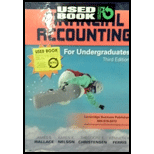
Compute the following ratios
- a) Return on sales
- b)
Current ratio - c) Debt-to-total-assets ratio
- d) Free
cash flows , and
Comment on the trend in Company L’s profitability, liquidity, solvency, and free cash flows.
Explanation of Solution
a) Return on sales ratio: The ratio which evaluates the amount of net income earned for every dollar of net sales is referred to as return on sales ratio.
Compute the return on sales ratio for Company L for the year 2013.
Net income = €3,436 million
Net sales = €29,016 million
Compute the return on sales ratio for Company L for the year 2014.
Net income = €5,648 million
Net sales = €30,638 million
b) Current ratio: Current ratio is one of the
Compute current ratio for Company L for the year 2013.
Current assets = €15,971 million
Current liabilities = €11,639 million
Compute current ratio for Company L for the year 2014.
Current assets = €18,110 million
Current liabilities = €12,175 million
c) Debt to Asset Ratio: Debt to asset ratio is the ratio between total asset and total liability of the company. Debt ratio reflects the finance strategy of the company. It is used to evaluate company’s ability to pay its debts. Higher debt ratio implies the higher financial risk.
Compute debt-to-total-assets ratio for Incorporation G for the year 2013.
Total assets = €56,176 million
Total liabilities = €28,269 million
Compute debt-to-total-assets ratio for Incorporation G for the year 2014.
Total assets = €53,362 million
Total liabilities = €30,359 million
Note: Total liabilities include current liabilities and non-current liabilities.
d) Free cash flow: Free cash flow describes the net cash provided from operating activities after making required adjustments for capital expenditures. In other words, it is the cash flow arrived after making payment for capital expenditures.
Compute free cash flow for Company L for the years 2013 and 2014.
| Particulars | 2013 | 2014 |
| In millions | ||
| Cash flow from operating activities | £4,714 | £4,607 |
| Less: Cash investment in property and equipment | 1,657 | 1,775 |
| Free cash flow | £3,057 | £2,832 |
Table (1)
Comments:
Trends in Company L’s profitability:
- Profitability of Company L is measured by return on sales ratio.
- The ratio is has increased a little from 11.84% in 2013 to 18.43% in 2014.
- This shows that the company’s profitability is improved.
Trends in Company L’s liquidity:
- Liquidity of Company L is evaluated by current ratio.
- The ratio shows a decreasing trend from 1.37 in 2013 to 1.48 in 2014.
- This shows that the capacity to pay for short-term liabilities has decreased.
Trends in Company L’s solvency:
- Liquidity of Company L is measured by debt-to-total assets ratio.
- The ratio shows a decreasing trend from 50.32% in 2013 to 56.89% in 2014.
- This shows that the repaying capacity of the corporation has increased.
Trends in Company L’s free cash flow:
- The computation shows a decreased to £2,832 in 2014 from £3,057 in 2013.
- But yet Company L has a healthy free cash flow in the years to repay its lenders, pay dividends to stockholders.
Want to see more full solutions like this?
Chapter 4 Solutions
FINANCIAL ACCT.F/UNDERGRADS-W/ACCESS
- Bruno Manufacturing uses direct labor-hours in its predetermined overhead rate. At the beginning of the year, the total estimated manufacturing overhead was $680,000. At the end of the year, actual direct labor-hours for the year were 42,500 hours, manufacturing overhead for the year was underapplied by $25,500, and the actual manufacturing overhead was $695,000. The predetermined overhead rate for the year must have been closest to: A) $16.00 B) $15.75 C) $16.35 D) $16.94arrow_forwardWhat was manufactured overhead?arrow_forwardWhich of the following choices is the correct status of manufacturing overhead at year-end?arrow_forward
- Morris Corporation applies manufacturing overhead at the rate of $40 per machine hour. Budgeted machine hours for the current period were anticipated to be 200,000; however, higher than expected production resulted in actual machine hours worked of 225,000. Budgeted and actual manufacturing overhead figures for the year were $8,000,000 and $8,750,000, respectively. On the basis of this information, the company's year-end overhead was: A. overapplied by $250,000 B. underapplied by $250,000 C. overapplied by $750,000 D. underapplied by $750,000arrow_forwardAt the beginning of the year, manufacturing overhead for the year was estimated to be $560,000. At the end of the year, actual labor hours for the year were 35,000 hours, the actual manufacturing overhead for the year was $590,000, and the manufacturing overhead for the year was underapplied by $30,000. If the predetermined overhead rate is based on direct labor hours, then the estimated labor hours at the beginning of the year used in the predetermined overhead rate must have been ___ hours.arrow_forwardGive me Answerarrow_forward

 AccountingAccountingISBN:9781337272094Author:WARREN, Carl S., Reeve, James M., Duchac, Jonathan E.Publisher:Cengage Learning,
AccountingAccountingISBN:9781337272094Author:WARREN, Carl S., Reeve, James M., Duchac, Jonathan E.Publisher:Cengage Learning, Accounting Information SystemsAccountingISBN:9781337619202Author:Hall, James A.Publisher:Cengage Learning,
Accounting Information SystemsAccountingISBN:9781337619202Author:Hall, James A.Publisher:Cengage Learning, Horngren's Cost Accounting: A Managerial Emphasis...AccountingISBN:9780134475585Author:Srikant M. Datar, Madhav V. RajanPublisher:PEARSON
Horngren's Cost Accounting: A Managerial Emphasis...AccountingISBN:9780134475585Author:Srikant M. Datar, Madhav V. RajanPublisher:PEARSON Intermediate AccountingAccountingISBN:9781259722660Author:J. David Spiceland, Mark W. Nelson, Wayne M ThomasPublisher:McGraw-Hill Education
Intermediate AccountingAccountingISBN:9781259722660Author:J. David Spiceland, Mark W. Nelson, Wayne M ThomasPublisher:McGraw-Hill Education Financial and Managerial AccountingAccountingISBN:9781259726705Author:John J Wild, Ken W. Shaw, Barbara Chiappetta Fundamental Accounting PrinciplesPublisher:McGraw-Hill Education
Financial and Managerial AccountingAccountingISBN:9781259726705Author:John J Wild, Ken W. Shaw, Barbara Chiappetta Fundamental Accounting PrinciplesPublisher:McGraw-Hill Education





